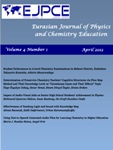Impact of Audio-Visual Aids on Senior High School Students’ Achievement in Physics
DOI:
https://doi.org/10.51724/ijpce.v4i1.92Keywords:
Audio-Visual Aids, Senior High School, Physics Achievement, Traditional MethodAbstract
This study was aimed at finding out the impact audio-visual-aided instruction on students’ achievement in physics at Cape Coast township of Cape Coast Metropolis, Ghana. The study was a non-randomized pre-test/post-test group design. A total of 65 students in Senior High School (SHS) formed the sample for the study. The students were fourth year science students from two purposefully selected co-educational SHS. The two selected schools were randomly designated experimental and control groups respectively. A validated physics achievement test instrument of a reliability coefficient of 0.76 was administered. Analysis of Covariance (ANCOVA) and t-test statistics were used to test the two hypotheses formulated to guide the study at a significance level 0.05. The results showed that SHS students taught with audio-visual aided instruction performed better than those taught with traditional method. The mean achievement scores of both male and female students improved significantly by the use of the audio-visual aided instruction. It was therefore recommended that SHS physics teachers should explore the use of audio-visual-aided instruction to teach the subject, physics.
Downloads
References
Aremu, S.A. (1992). The need, usefulness and effectiveness of instructional materials for meaningful teaching and learning. Lagos: Academic Publications. Associations of Nigeria.
Barbosa, M. (2003). Equity for women in physics. Physics World, 34, 45-46.
Buabeng, I. & Ntow, D.F. (2010). A comparison study of students’ reasons/views for choosing/not choosing physics between undergraduate female non-physics and female physics students at University of Cape Coast. International Journal of Research in Education, 2(2), 44-53.
Cohen, J.W. (1988). Statistical power analysis for the behavioural sciences (2nd ed.). Hillsdale, New Jersey: Lawrence Erlbaum Associates.
Dabbagh, N. (2001). Concept mapping as mind tool for critical thinking, Journal of Computing in Teacher Education, 17(2), 15-24.
Dale, E. (1996). Audio-visual methods in teaching. New York: Dryden Press.
Donnellan, C. (2003). Does sex make a difference? An equalities peak for young people on international women’s day. The Gender Issues, 64, 14-17.
Fillmore, C. (2008). A smarter way to teach physics. Paper presented at the International Education Research Conference, Brisbane, Australian. Retrieved date: February 20, 2011, from http://www.aare.edu.au/08pap/fil081140.pdf
Fraenkel, J.R. & Wallen, N.E. (2000). How to design and evaluate research in education. New York: Mc Grawhill Companies Inc.
Isola, O.M. (2010). Effects of standardized and improvised instructional materials on students’ academic achievements in secondary school physics. Unpublished Master of Education Thesis, University of Ibadan, Ibadan.
King, J.W. (1990). Using media in teaching. Teaching at UNL, NE: Teaching and Learning Centre, the University of Nebraska-Lincoln.
Kochhar, S.K. (2004). Methods and techniques of teaching. New Delhi: Publishers Pvt. Ltd.
Le Doux, J. (1996). The emotional brain: The mysterious underpinnings of emotional life. New York: Simon and Schuster.
Mitchell, N.L. & Surprise, S.J. (1994). Effective use of video in interactive modules. Proceedings on World Conference on Educational multi-media an hypermedia, Vancouver, Canada. Retrieved February 20, 2011, from http://outerlimitsresearch.wikispaces.com/Reseach
Nacino-Brown, R., Oke, F.E. & Brown, D.P. (1985). Curriculum and instruction: An introduction to methods of teaching. London: Macmillan Publishers
Okwo, F.A. (1994). Appropriate media technique for rural development communication and education in Nigeria. Journal of Quality Education, 1(1), 36-45.
Oladajo, M.A., Olosunde, G.R., Ojebisi, A.O. & Isola, O.M. (2011). Instructional materials and students’ academic achievement in physics: Some policy implications. European Journal of Humanities and Social Sciences, 2(1), 113-126.
Omosewo, E.O. (1999). Relative effects of planned post-laboratory discussion on students’ achievement in physics. Journal of Educational Foundations, 4(2), 116-121.
Osokoya, I.O. (2007). Effects of video-taped instruction on secondary school students’ achievement in history, International Journal of African & African American Studies, 6(1), 27-34.
Ouellette, R.P. (2004). The challenges of distributed learning as new paradigm for teaching and learning. College Park, USA: University of Maryland College.
Owusu, K.A., Monney, K.A., Appiah J.Y. & Wilmot, E.M. (2010). Effects of computer-assisted instruction on performance of senior high school biology students in Ghana, Computer and Education, 55, 904-910.
Paas, F., Renkl, A. & Sweller, J. (2004). Cognitive load theory: Instructional implications of the interaction between information structures and cognitive architecture. Instructional Science, 32(1-2), 1-8.
Prow, T. (2003). Physics is hard, not impossible. Engineering Outlook, 42, 1-8.
Smithers, A. & Robinson, P. (2007). Physics in school and universities III: Bucking the trend. Centre for Education and Employment Research, University of Buckingham.
Tamakloe, E.K. Atta, E.T, & Amedahe, F. K. (2005). Principles and methods of teaching. Accra: Ghana University Press.
Wambugu, P.W., Changeiywo, M. J. (2008). Effects of mastery learning approach on secondary school students’ physics achievement. Eurasia Journal of Mathematics, Science & Technology Education, 4(3), 293-302.
Downloads
Published
How to Cite
Issue
Section
License
Copyright (c) 2012 Eurasian Journal of Physics & Chemistry Education

This work is licensed under a Creative Commons Attribution-NonCommercial 4.0 International License.
Copyright © Authors






